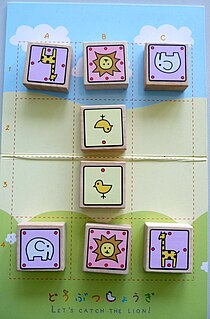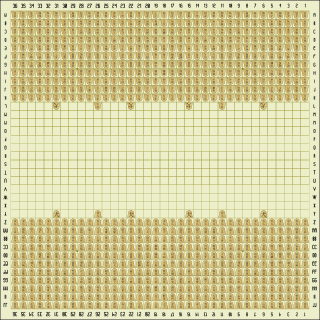 W
WA shogi variant is a game related to or derived from Japanese chess. Many shogi variants have been developed over the centuries, ranging from some of the largest chess-type games ever played to some of the smallest. A few of these variants are still regularly played, though none are as popular as shogi itself.
 W
WChu shogi is a strategy board game native to Japan. It is similar to modern shogi in its rules and gameplay. Its name means "mid-sized shogi", from a time when there were three sizes of shogi variants that were regularly being played. Chu shogi seems to have been developed in the early 14th century as a derivative of dai shogi. There are earlier references, but it is not clear that they refer to the game as we now know it.
 W
WDai shogi or Kamakura dai shogi (鎌倉大将棋) is a chess variant native to Japan. It derived from Heian era shogi, and is similar to standard shogi in its rules and game play. Dai shogi is only one of several large board shogi variants. Its name means large shogi, from a time when there were three sizes of shogi games. Early versions of dai shogi can be traced back to the Kamakura period, from about AD 1230. It was the historical basis for the later, much more popular variant chu shogi.
 W
WDōbutsu shōgi is a small shogi variant for young children. It was invented by women's professional shogi player Madoka Kitao , partially to attract young girls to the game. It is played on a 3×4 board and generally follows the rules of standard shogi, including drops, except that pieces can only move one square at a time, and the king reaching the enemy camp as an additional way to win the game.
 W
WThe Shōgi Zushiki (象戯図式), Sho Shōgi Zushiki (諸象戯図式), and Shōgi Rokushu no Zushiki (象棋六種之図式) are Edo period publications describing various variants of Japanese chess, otherwise known as shōgi.
 W
WEuroShogi is a shogi variant invented by Vladimír Pribylinec starting in 2000. The game developed from an early version of chess variant Echos in 1977, leading to Cubic Chess, then later to Cubic Shogi, and finally to EuroShogi. Instead of the classic figures, 18 black and 18 black cubes are used, which are on two opposing sides without symbols. The other two cubes on the opposite sides have one white and one black symbol. The other opposing sides are the same symbols of the opposite color - their promotion is indicated by a circle around symbol. Symbol on top of its mobility. The pieces are placed on the board so that they are oriented towards players without any symbolic surfaces. Plays on a board with 8x8 fields of the same color.
 W
WHasami shogi is a variant of shogi. The game has two main variants, and all Hasami variants, unlike other shogi variants, use only one type of piece, and the winning objective is not checkmate. One main variant involves capturing all but one of the opponent's men; the other involves building an unbroken vertical or horizontal chain of five-in-a-row.
 W
WHexshogi is a shogi variant for two players created by George R. Dekle Sr. in 1986. The gameboard comprises 85 hexagonal cells. The game is in all respects the same as shogi, except that piece moves have been transfigured for the hexagonal board-cell geometry.
 W
WKyoto shogi is a modern variant of shogi. It was invented by Tamiya Katsuya c. 1976.
 W
WMasonic shogi is a shogi variant invented by George R. Dekle Sr. in 1987. The game is played on a modified shogi board whereby alternating ranks are indented to the right—resembling masonry brickwork. The moves of pieces are adapted to the new geometry; in other respects the game is the same as shogi.
 W
WMicroshogi is a modern variant of shogi, with very different rules for promotion, and demotion. Kerry Handscomb of NOST gave it this English name. Although not confirmed, he credits its invention to the late Oyama Yasuharu, a top level shogi player. The game was invented before 1982.
 W
WMinishogi is a modern variant of shogi. The game was invented around 1970 by Shigenobu Kusumoto of Osaka, Japan. The rules are nearly identical to those of standard shogi, with the exception that it is played on a 5x5 board with a reduced number of pieces, and each player's promotion zone consists only of the rank farthest from the player.
 W
WSpace shogi is a three-dimensional shogi variant invented by George R. Dekle Sr. in 1987. The gamespace comprises nine 9×9 shogi boards stacked vertically. Each player controls a standard set of shogi pieces.
 W
WTaikyoku shōgi is the largest known variant of shogi. The game was created around the mid-16th century and is based on earlier large board shogi games. Before the rediscovery of taikyoku shogi in 1997, tai shogi was believed to be the largest playable chess variant ever. It has not been shown that taikyoku shogi was ever widely played. There are only two sets of restored taikyoku shogi pieces and one of them is held at Osaka University of Commerce. One game may be played over several long sessions and require each player to make over a thousand moves.
 W
WTori shōgi is a variant of shogi, which was invented by Toyota Genryu in 1799 despite being traditionally attributed to his master Ōhashi Sōei. It was first published in 1828 and again in 1833. The game is played on a 7×7 board and uses the drop rule; it is the only traditional shogi variant, possibly besides wa shogi, to do so. This is one of the more popular shogi variants. There were tournaments in London and Royston in the 1990s and early 2000s.
 W
WTrishogi is a shogi variant for two players created by George R. Dekle Sr. in 1987. The gameboard comprises 9×10 interlocking triangular cells. The game is in all respects the same as shogi, except that piece moves have been transfigured for the triangular board-cell geometry.
 W
WYonin shōgi,, is a four-person variant of shogi. It may be played with a dedicated yonin shogi set or with two sets of standard shogi pieces, and is played on a standard sized shogi board.